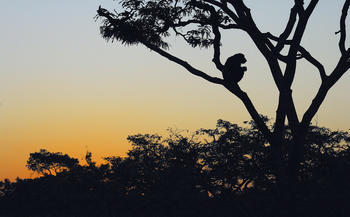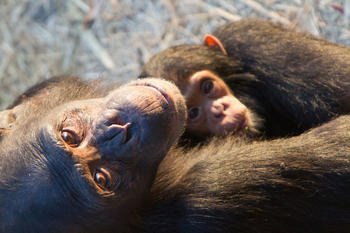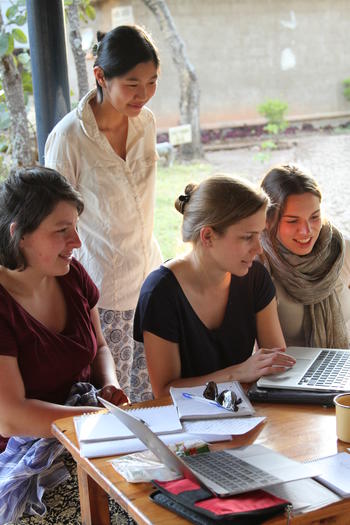The Savanna as a Lecture Hall
In a unique course, students observe chimpanzees in Zambia.
Oct 05, 2016
Students and researchers from Freie Universität do field work in the savanna in Chimfunshi.
Image Credit: Katja Liebal
In Chimfunshi students and scientists can observe the behavior of chimpanzees from close up.
Image Credit: Katja Liebal
The data are then evaluated on site.
Image Credit: Katja Liebal
Glaring sunlight, a red sand floor, the unique sounds of the bush and grassland landscapes of Zambia, home to cicadas and more than 700 species of birds – about 30 hours of travel away from Berlin, a whole different world awaits: Chimfunshi, in the north of Zambia.
Here, at one of the largest chimpanzee refuges in the world, the great apes live in vast enclosures, where they enjoy the utmost freedom. This unique project gives fans of nature and scientists alike an opportunity to observe everyday life among the apes up close.
Among them are 12 students from Freie Universität, their professor, Katja Liebal, and her research assistants, who – loaded down with video cameras, telescopes, tripods, and gifts for their hosts – set off on the long journey to Zambia. The flight was followed by a six-hour bus ride through rough, dusty terrain. “You do have to really want to go,” Liebal says. “But once you arrive at Chimfunshi, all your efforts are rewarded.”
There, in the imposing Zambian savanna landscape, the team from Berlin planned to do small-scale field research on issues in behavioral biology and developmental psychology. The psychology students had spent months preparing for these two weeks in one of their courses.
Then, in June, the big day had finally arrived. Participant Svenja Witte (20) describes her first impressions. “I had never been to Africa before, so everything was completely new to me. For example, I was surprised to see that there are supermarkets there, just like at home, and even some of the same stores. But most of all, I thought it was great how incredibly nice and helpful the local people were,” she says. Chimfunshi itself covers a sprawling area, which is left entirely untouched – so it offers perfect conditions for gathering data on the animals’ behavior with maximum authenticity.
Witte’s group had mapped out a research project on the dominance behavior of alpha males before the trip. “Scientists believe there are different leadership styles among chimpanzees. One hypothesis is that alpha males with high body weight are especially aggressive, while smaller individuals tend more toward cooperative behavior,” explains Witte’s fellow student Tom Hovehne.
One-hour Hike to Outdoor Chimpanzee Enclosure – Every Morning
The young psychologists wanted to check their hypothesis in Zambia. To do so, they made a one-hour trek to the enclosures, which are located a bit farther away, every morning in order to document the chimpanzees’ behavior by video camera. “It was harder than we thought at first,” Witte recalls. After all, researchers are not allowed to go right up to the animals. Instead, they had to film from the fence, or down from observation platforms, she explains. “Plus, chimpanzees move extremely fast. It’s really hard to wait for an exciting scene and capture good material on film,” Witte says.
Patience is one of a field researcher’s primary virtues, as Liebal knows from years of experience. A professor of comparative developmental psychology at Freie Universität Berlin, Liebal (40) focuses on communication among primates, including humans, in her research. Her method of systematic comparison of species and cultures is a relatively new direction in research in Germany, and one in which relatively few scholars are working at present.
“What I am investigating is what kinds of communicative and cognitive behaviors we find among all or some great apes, and which are unique to humans. So the question is ultimately what makes us human,” she says. “With this kind of field research, you are constantly discovering new things that give rise to many follow-up questions. I wanted to share this wonderful experience with the students while also giving them the chance to get to know a country as exciting and diverse as Zambia.”
Liebal has been familiar with working at Chimfunshi for a while now. She has been there several times to do research with colleagues. One aspect that is especially important to her is that the rescue center not only makes an important contribution from the standpoint of species and nature conservation, but also helps the local people. “Chimfunshi initially arose from a private initiative,” she explains. At first, there were only a few chimpanzees living there. The first few chimps had previously been kept as pets, confiscated from smugglers by customs authorities, or had been circus animals, an existence that is not very appropriate for the species. The project, which is financed primarily through donations from Germany, now houses about 130 apes and is an important local employer.
Participants in the steadily expanding project live in villages in and around the refuge, which encompasses more than 4,200 hectares. In addition to a school and a medical station, the reserve also has a research center, which serves as a central access point for international scientists and researchers, tourists, and school classes.
“It’s only about a five-minute walk from the station to one of the villages,” Hovehne says. “That meant we had a chance to get to know the local people and play soccer with the kids in the village in the afternoon.” In the evenings, the group cooked together, ate by the campfire, and sang songs. “We talked a lot with people from the local area, which was very interesting. We got a good impression of the indigenous culture,” says Hovehne, who is 19.
“The trip to Chimfunshi is a valuable experience for the students, both academically and personally,” Liebal says. “At the same time, though, it’s important to me for us not to just be there for two weeks and then leave; we need to give something back to the people there, too.” With that in mind, Liebal plans to start a lasting cooperative relationship, including an annual excursion, and invite participation from Zambian students as well. “We are currently in talks with the University of Zambia in Lusaka. I would really like to see students from Lusaka and Berlin develop and implement research projects together, and for each group to travel to the other partner country.”
While the project’s funding is secure for the next four years through a grant from the Volkswagen Foundation, Liebal hopes to raise funds beyond that as well. There is certainly no reason to worry about any lack of potential participants. “The students told me they would like to all fail the test,” Liebal says with a laugh. “Then they could come along again next year.”
Further Information
- Prof. Katja Liebal, Freie Universität Berlin, Department of Education and Psychology, Comparative Developmental Psychology, Email: katja.liebal@fu-berlin.de
- The Chimfunshi Verein zum Schutz bedrohter Umwelt e.V., a non-profit organization with the aim of supporting the Chimfunshi Wildlife Orphanage, has its own homepage: www.chimfunshi.de



